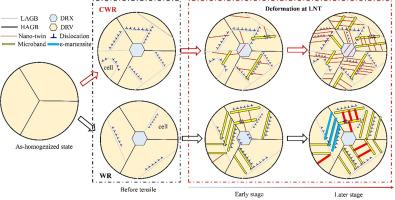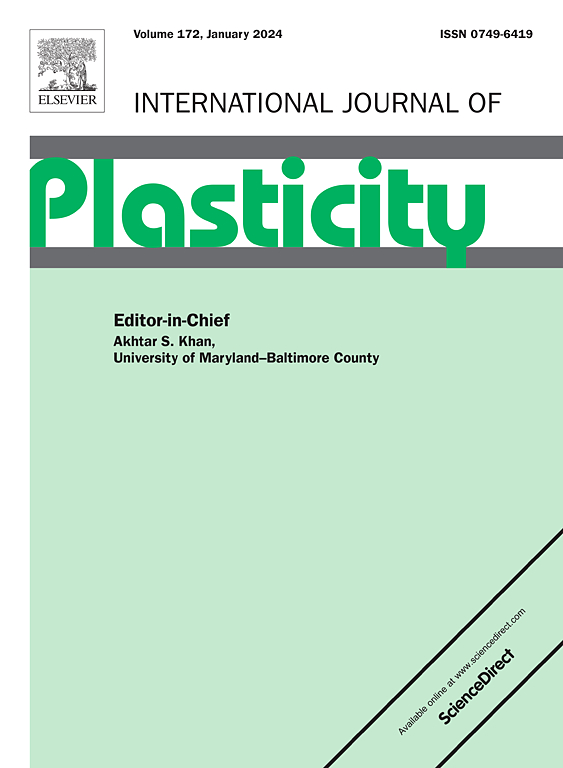Influences of dislocation configuration and texture optimization on obtaining exceptional cryogenic strength-ductility synergy in a dynamic-recovered heterogeneous high-manganese steel
IF 9.4
1区 材料科学
Q1 ENGINEERING, MECHANICAL
引用次数: 0
Abstract
In this study, an innovative strategy of dislocation configuration and texture optimization is employed to achieve a heterogeneous dynamic-recovered (DRV) high-manganese steel via successive cold-warm-rolling (CWR). Compared with single-step warm-rolling (WR) treatment, the imposed cold deformation of CWR process not only results in more and finer dislocation cells in DRV grains, but also leads to texture optimization with intensity weakening and component changing. Hence, the CWR sample shows a higher yield strength (YS, ∼1.35 GPa) and ultimate tensile strength (UTS, ∼1.6 GPa) without sacrificing the tensile elongation (TEL, ∼57%) at LNT (liquid nitrogen temperature), accompanied with a significantly lower mechanical anisotropy. The exceptional cryogenic strength-ductility synergy can be attributed to following: i) the difference of YS comes from the additional Taylor hardening effect (∼150 MPa); ii) the prefer-orientated DRV grains with a high Schmid factor (SFR) of twinning induces the twin deflections or kinks at the dislocation boundary in the early deformation stage; and iii) the refined cell structure can increase the critical resolved shear stress (CRSS) of twin, act as twin nucleus and impede its growth, leading to the occurrence of high-density of nano-twin segment (thickness: ∼15 nm, number density: ∼1.1 × 108 m-3) at a high stress and strain level. Thus, the cooperative forest dislocation hardening (∼870 MPa) and dynamic Hall-Petch strengthening (∼220 MPa) effects can provide continuous strain hardening capacity. In contrast, the high ductility of the WR sample primarily originates from the abundant microband-induced plasticity correlated with limited twinning- (TWIP) and transformation-induced plasticity (TRIP) due to a coarse twin (∼22.5 nm) and martensite thickness (∼55 nm).


位错结构和织构优化对动态回收非均相高锰钢获得超常低温强度-塑性协同效应的影响
在本研究中,采用一种创新的位错构型和织构优化策略,通过连续冷温轧制(CWR)实现了高锰钢的非均质动态恢复(DRV)。与单步温轧(WR)处理相比,CWR工艺的冷变形不仅使DRV晶粒中出现了更多更细的位错细胞,而且使织构优化,强度减弱,成分变化。因此,CWR样品在LNT(液氮温度)下表现出更高的屈服强度(YS, ~ 1.35 GPa)和极限抗拉强度(UTS, ~ 1.6 GPa),而不牺牲抗拉伸长率(TEL, ~ 57%),同时力学各向异性显著降低。特殊的低温强度-延性协同作用可归因于以下原因:1)YS的差异来自额外的泰勒硬化效应(~ 150 MPa);ii)高施密德因子(SFR)的择优取向DRV晶粒在变形初期在位错边界处诱发孪晶挠曲或扭结;精细的晶胞结构增加了孪晶的临界分解剪切应力(CRSS),起到孪晶核的作用,阻碍孪晶的生长,导致在高应力应变水平下出现纳米孪晶段高密度(厚度:~ 15 nm,数密度:~ 1.1 × 108 m-3)。因此,协同森林位错硬化(~ 870 MPa)和动态Hall-Petch强化(~ 220 MPa)效应可以提供连续应变硬化能力。相比之下,WR样品的高延展性主要源于丰富的微带诱导塑性,这与有限的孪晶(TWIP)和由粗孪晶(~ 22.5 nm)和马氏体厚度(~ 55 nm)引起的相变诱导塑性(TRIP)有关。
本文章由计算机程序翻译,如有差异,请以英文原文为准。
求助全文
约1分钟内获得全文
求助全文
来源期刊

International Journal of Plasticity
工程技术-材料科学:综合
CiteScore
15.30
自引率
26.50%
发文量
256
审稿时长
46 days
期刊介绍:
International Journal of Plasticity aims to present original research encompassing all facets of plastic deformation, damage, and fracture behavior in both isotropic and anisotropic solids. This includes exploring the thermodynamics of plasticity and fracture, continuum theory, and macroscopic as well as microscopic phenomena.
Topics of interest span the plastic behavior of single crystals and polycrystalline metals, ceramics, rocks, soils, composites, nanocrystalline and microelectronics materials, shape memory alloys, ferroelectric ceramics, thin films, and polymers. Additionally, the journal covers plasticity aspects of failure and fracture mechanics. Contributions involving significant experimental, numerical, or theoretical advancements that enhance the understanding of the plastic behavior of solids are particularly valued. Papers addressing the modeling of finite nonlinear elastic deformation, bearing similarities to the modeling of plastic deformation, are also welcomed.
 求助内容:
求助内容: 应助结果提醒方式:
应助结果提醒方式:


